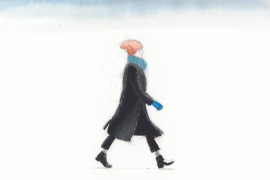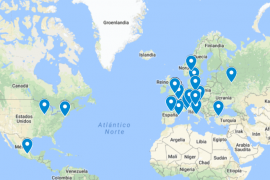
In a few years on the market, Tesla has established...

The unremitting human emancipation from nature –transformed into “culture”– is...

In this day of International Business promoted by Banco Sabadell,...

Would you like to walk around with the Giocconda under...

Find out which are the 26 restaurants with Michelin Star...

The CEO of Acció, Albert Castellanos, and the president of...

The explanation of the cold in our latitudes is in...

The rate of caravan registrations has increased by 347% in...

Three Catalan restaurants – El Celler de Can Roca (2),...

The most popular use of supercomputation in industry is the...

Música clásica sobre la arena de la playa en dos...

The first session of the cycle on the regatta organized...

The hospital's managing director, Manel del Castillo, and the pharmaceutical...

Generalitat y Ayuntamiento impulsarán dos equipamientos de 'Casa de les...

Leticia Beleta, director of Alexion Pharmaceuticals in Spain and Portugal,...

We all have a friend who never leaves the Gràcia...

Barcelona director opts for Best International Film with 'La sociedad...

The hotel and industrial sectors softened the market's decline last...

The technology company, with a workforce of 35 employees and...

“The women of yesteryear were strong and had to fight...
[dropcap letter=”N”]
ames of streets are called hodonyms. What a word! And the street names of Barcelona are regulated by the Commission on the Nomenclature of the Streets of Barcelona. According to a recent tally, there are 4,518 streets in the city, and the nomenclature includes public spaces and thoroughfares of all kinds: streets, alleys, squares, little squares, promenades, avenues, roads, ring roads, passages, lanes, stairs, parkways, lookout-points, roadways and motorways, in addition to quays, jetties, beaches, parks and gardens.
While there are streets whose names have not changed since the Middle Ages, those that pay tribute to people or political regimes are naturally more controversial. Diagonal has had up to eight different names since it was built in the mid-19th century
In the most distant past, when the city was more reasonably sized, the majority of streets did not even have a name, and people often referred to them using terms related to the trades performed there or the physical features found on the street. Many medieval names survive even today in the historical neighbourhoods; they hark back to the owners of the most prominent houses or to the guilds that were located there: Carders (the same in English, wool carders), Assaonadors (tanners), Basses de Sant Pere (referring to the pools, or basses, of the flour mills that used to be there), Tapineria (clog-makers), Agullers (needle-makers), and so on. It was not until the mid-19th century that signs with the official street names started to be installed. And this is when the problems began.
While there are streets whose names have not changed since the Middle Ages, those that pay tribute to people or political regimes are naturally more controversial. Diagonal has had up to eight different names since it was built in the mid-19th century: Gran Vía Diagonal (1860), Argüelles (1874), Nacionalitat Catalana (1922), Alfonso XIII (1924), 14 de Abril (1931), Gran Vía Diagonal (1939), Generalísimo Franco (1939) and Avinguda Diagonal (1979). This succession of names sheds light on quite an accurate a subtext of the political vicissitudes of Barcelona in the past century and a half.
The last and most hotly debated case is the removal of the statue devoted to Antonio López y López. López was born to a humble family in Cantabria. He moved to Seville as a child and then went to Cuba to flee justice after an obscure street fight
Modern urban toponymy is so unstable that it mutates at the whim of political, social and ideological changes. Counter to the utilitarian vision of traditional toponymy, the symbolic power of being able to name the public space seduces politicians, who in recent years have unleashed a series of controversies in their zeal to reflect parliamentary majorities, majority values or social consensuses on the names of streets or the presence of monuments. And this is coupled with increasing citizen participation in the decisions to name new streets or change the names of existing ones.
The last and most hotly debated case is the removal of the statue devoted to Antonio López y López. López was born to a humble family in Cantabria. He moved to Seville as a child and then went to Cuba to flee justice after an obscure street fight. There he got his start as a modest merchant on the ground floor of a building owned by a prosperous Catalan merchant, Andre Bru Punyet. He ended up marrying Bru Punyet’s daughter, which allowed him to draw from his in-laws’ fortune to undertake large-scale business projects. He made his fortune by creating the Compañía Transatlàntica in 1850, and later he became immensely wealthy thanks to companies like the Compañía de Tabacos de Filipinas and Banco Hispano Colonial. A close friend of King Alphonse XII, his son-in-law was Eusebi Güell and his descendants played a prominent role in the golden years of Barcelona’s expansion. He was a patron of the arts and a tireless entrepreneur, and he amassed an incredible fortune for the era.
But his purported activities as a slave merchant while he was still in Cuba, which we know about through the testimony of his brother-in-law, Francesc Bru (better known as Pancho Bru), who devoted an enraged pamphlet to him entitled ‘The true life of Antonio López y López’’, ended up leading to the defenestration of his monument. The sculpture, which has since been removed, is a work by the prominent sculptor Frederic Marès (there was a previous one, which was destroyed at the beginning of the Civil War) which now languishes in the warehouse of the History Museum of Barcelona (MUHBA). Plaça d’Antonio López still bears his name for the time being, although the pedestal that used to hold his statue is now bare. A participative process will be needed to assign the square a new name, and the possible candidates include Plaça de les Bullangues (in homage to the grassroots uprisings called bullangues) or Plaça d’Idrissa Diallo, an immigrant who died in 2012 at the Foreigner Internment Centre (CIE) in the Zona Franca.
Although the names of the majority of streets which paid homage to the Franco regime were changed during the Transition, others still survive which commemorate more distant historical figures who are nonetheless questionable. One example is the street named after Secretari Coloma, a fierce inquisitor and promoter of the expulsion of the Jews from the Iberian Peninsula
López’s case is not unique. Many of the most illustrious surnames have ancestors in their genealogical tree whose behaviours would not pass through the filter of today’s political correctness. For example, we can recall that in 1872, two decades after López left his businesses in the Caribbean and moved to Barcelona, a group of Barcelona grandees signed a manifesto against the abolition of slavery in Cuba. The signatories include two future bishops, Morgades and Casañas; intellectuals like Rubió i Ors and Duran i Bas; physicians like José de Letamendi; and industrialists and bankers like Güell, Arnús and Ferrer i Vidal. They are all represented in Barcelona’s nomenclature today. It is worth noting that Spain did not approve the law establishing the abolition of slavery in Cuba until 1880 and that there were anti-abolitionist leagues and demonstrations in many cities around Spain during the same period.
And there are even more controversial cases. Although the names of the majority of streets which paid homage to the Franco regime were changed during the Transition, others still survive which commemorate more distant historical figures who are nonetheless questionable. One example is the street named after Secretari Coloma, a fierce inquisitor and promoter of the expulsion of the Jews from the Iberian Peninsula, which will soon get back its original name, Pau Alsina, in memory of a textile worker who ended up becoming a senator in the Spanish courts. The decision was taken by the residents after a consultation from the Town Hall.
The desire to settle historical accounts can go too far: several times the CUP party has formally requested the removal of the statue to Christopher Columbus, an emblem of Barcelona’s skyline but one that has been questioned because of his role in the colonisation of the Americas. There are also streets which go largely unnoticed, but if we look closely they are actually problematic. One example is Sant Domènec del Call. On the 5th of August 1391, more than 300 Jews in Barcelona’s Jewish Quarter were slaughtered, the largest known pogrom in Barcelona which virtually put an end to the city’s Jewish community. The slaughter took place around the Feast Day of Saint Dominick, and the street was named in his honour, although it had previously been known as Carrer de les Carnisseries (not in the sinister sense of carnage or massacre but because kosher meat could be purchased there). Commemorating a pogrom by paying tribute to a Catholic saint can seem aesthetically questionable at the very least.
Just two years ago, a former train station in Paris, Halle Freyssinet, was transformed into a huge incubator for start-ups, and the promoters had the idea of naming one of the new streets after Steve Jobs. The mayor soon faced opposition from some political groups who accused Jobs of being a modern Antonio López because of the working conditions of the Chinese labourers who manufacture Apple devices
Other changes are less controversial. Soon, on the 15th of April, the name of the comedian Pepe Rubianes will replace that of Almirall Cervera on the street signs on one of the broadest streets in the Barceloneta neighbourhood. Cervera was a prominent military man in the Spanish Marines who fought in the wars in the Philippines and Cuba, where his performance as an officer was not particularly memorable. It is unlikely that many people will miss him, and Rubianes is more accessible and likeable to the majority of residents.
But let’s not think that the controversy over the names of streets and public spaces is unique to our city. It happens everywhere, and not only in relation to figures from the past. Just two years ago, a former train station in Paris, Halle Freyssinet, was transformed into a huge incubator for start-ups, and the promoters had the idea of naming one of the new streets after Steve Jobs. The mayor soon faced opposition from some political groups who accused Jobs of being a modern Antonio López because of the working conditions of the Chinese labourers who manufacture Apple devices. Not to mention the company’s policy of tax fraud in Europe. In exchange, they suggested the name of Ada Lovelace, a pioneer in the information technologies and the creator of the first computer programme. The ultimate solution was Solomonic: the transformed station is called Station F, and the street was ultimately dedicated to Alan Turing, a British scientist who was a pioneer in computing and artificial intelligence and who was punished for his homosexuality and ended up committing suicide.
Perhaps the only way to smooth the kinks out of nomenclature and save it from constant controversy would be to adopt a radical decision and replace all the names by numbers, following the model of Manhattan and other American cities, and to erase traces of a not always worthy history from public space forevermore. Or even better, to trust the new technologies and refer to places by their geographic coordinates, which are simultaneously aseptic and indisputable.
[dropcap letter=”N”]
ames of streets are called hodonyms. What a word! And the street names of Barcelona are regulated by the Commission on the Nomenclature of the Streets of Barcelona. According to a recent tally, there are 4,518 streets in the city, and the nomenclature includes public spaces and thoroughfares of all kinds: streets, alleys, squares, little squares, promenades, avenues, roads, ring roads, passages, lanes, stairs, parkways, lookout-points, roadways and motorways, in addition to quays, jetties, beaches, parks and gardens.
While there are streets whose names have not changed since the Middle Ages, those that pay tribute to people or political regimes are naturally more controversial. Diagonal has had up to eight different names since it was built in the mid-19th century
In the most distant past, when the city was more reasonably sized, the majority of streets did not even have a name, and people often referred to them using terms related to the trades performed there or the physical features found on the street. Many medieval names survive even today in the historical neighbourhoods; they hark back to the owners of the most prominent houses or to the guilds that were located there: Carders (the same in English, wool carders), Assaonadors (tanners), Basses de Sant Pere (referring to the pools, or basses, of the flour mills that used to be there), Tapineria (clog-makers), Agullers (needle-makers), and so on. It was not until the mid-19th century that signs with the official street names started to be installed. And this is when the problems began.
While there are streets whose names have not changed since the Middle Ages, those that pay tribute to people or political regimes are naturally more controversial. Diagonal has had up to eight different names since it was built in the mid-19th century: Gran Vía Diagonal (1860), Argüelles (1874), Nacionalitat Catalana (1922), Alfonso XIII (1924), 14 de Abril (1931), Gran Vía Diagonal (1939), Generalísimo Franco (1939) and Avinguda Diagonal (1979). This succession of names sheds light on quite an accurate a subtext of the political vicissitudes of Barcelona in the past century and a half.
The last and most hotly debated case is the removal of the statue devoted to Antonio López y López. López was born to a humble family in Cantabria. He moved to Seville as a child and then went to Cuba to flee justice after an obscure street fight
Modern urban toponymy is so unstable that it mutates at the whim of political, social and ideological changes. Counter to the utilitarian vision of traditional toponymy, the symbolic power of being able to name the public space seduces politicians, who in recent years have unleashed a series of controversies in their zeal to reflect parliamentary majorities, majority values or social consensuses on the names of streets or the presence of monuments. And this is coupled with increasing citizen participation in the decisions to name new streets or change the names of existing ones.
The last and most hotly debated case is the removal of the statue devoted to Antonio López y López. López was born to a humble family in Cantabria. He moved to Seville as a child and then went to Cuba to flee justice after an obscure street fight. There he got his start as a modest merchant on the ground floor of a building owned by a prosperous Catalan merchant, Andre Bru Punyet. He ended up marrying Bru Punyet’s daughter, which allowed him to draw from his in-laws’ fortune to undertake large-scale business projects. He made his fortune by creating the Compañía Transatlàntica in 1850, and later he became immensely wealthy thanks to companies like the Compañía de Tabacos de Filipinas and Banco Hispano Colonial. A close friend of King Alphonse XII, his son-in-law was Eusebi Güell and his descendants played a prominent role in the golden years of Barcelona’s expansion. He was a patron of the arts and a tireless entrepreneur, and he amassed an incredible fortune for the era.
But his purported activities as a slave merchant while he was still in Cuba, which we know about through the testimony of his brother-in-law, Francesc Bru (better known as Pancho Bru), who devoted an enraged pamphlet to him entitled ‘The true life of Antonio López y López’’, ended up leading to the defenestration of his monument. The sculpture, which has since been removed, is a work by the prominent sculptor Frederic Marès (there was a previous one, which was destroyed at the beginning of the Civil War) which now languishes in the warehouse of the History Museum of Barcelona (MUHBA). Plaça d’Antonio López still bears his name for the time being, although the pedestal that used to hold his statue is now bare. A participative process will be needed to assign the square a new name, and the possible candidates include Plaça de les Bullangues (in homage to the grassroots uprisings called bullangues) or Plaça d’Idrissa Diallo, an immigrant who died in 2012 at the Foreigner Internment Centre (CIE) in the Zona Franca.
Although the names of the majority of streets which paid homage to the Franco regime were changed during the Transition, others still survive which commemorate more distant historical figures who are nonetheless questionable. One example is the street named after Secretari Coloma, a fierce inquisitor and promoter of the expulsion of the Jews from the Iberian Peninsula
López’s case is not unique. Many of the most illustrious surnames have ancestors in their genealogical tree whose behaviours would not pass through the filter of today’s political correctness. For example, we can recall that in 1872, two decades after López left his businesses in the Caribbean and moved to Barcelona, a group of Barcelona grandees signed a manifesto against the abolition of slavery in Cuba. The signatories include two future bishops, Morgades and Casañas; intellectuals like Rubió i Ors and Duran i Bas; physicians like José de Letamendi; and industrialists and bankers like Güell, Arnús and Ferrer i Vidal. They are all represented in Barcelona’s nomenclature today. It is worth noting that Spain did not approve the law establishing the abolition of slavery in Cuba until 1880 and that there were anti-abolitionist leagues and demonstrations in many cities around Spain during the same period.
And there are even more controversial cases. Although the names of the majority of streets which paid homage to the Franco regime were changed during the Transition, others still survive which commemorate more distant historical figures who are nonetheless questionable. One example is the street named after Secretari Coloma, a fierce inquisitor and promoter of the expulsion of the Jews from the Iberian Peninsula, which will soon get back its original name, Pau Alsina, in memory of a textile worker who ended up becoming a senator in the Spanish courts. The decision was taken by the residents after a consultation from the Town Hall.
The desire to settle historical accounts can go too far: several times the CUP party has formally requested the removal of the statue to Christopher Columbus, an emblem of Barcelona’s skyline but one that has been questioned because of his role in the colonisation of the Americas. There are also streets which go largely unnoticed, but if we look closely they are actually problematic. One example is Sant Domènec del Call. On the 5th of August 1391, more than 300 Jews in Barcelona’s Jewish Quarter were slaughtered, the largest known pogrom in Barcelona which virtually put an end to the city’s Jewish community. The slaughter took place around the Feast Day of Saint Dominick, and the street was named in his honour, although it had previously been known as Carrer de les Carnisseries (not in the sinister sense of carnage or massacre but because kosher meat could be purchased there). Commemorating a pogrom by paying tribute to a Catholic saint can seem aesthetically questionable at the very least.
Just two years ago, a former train station in Paris, Halle Freyssinet, was transformed into a huge incubator for start-ups, and the promoters had the idea of naming one of the new streets after Steve Jobs. The mayor soon faced opposition from some political groups who accused Jobs of being a modern Antonio López because of the working conditions of the Chinese labourers who manufacture Apple devices
Other changes are less controversial. Soon, on the 15th of April, the name of the comedian Pepe Rubianes will replace that of Almirall Cervera on the street signs on one of the broadest streets in the Barceloneta neighbourhood. Cervera was a prominent military man in the Spanish Marines who fought in the wars in the Philippines and Cuba, where his performance as an officer was not particularly memorable. It is unlikely that many people will miss him, and Rubianes is more accessible and likeable to the majority of residents.
But let’s not think that the controversy over the names of streets and public spaces is unique to our city. It happens everywhere, and not only in relation to figures from the past. Just two years ago, a former train station in Paris, Halle Freyssinet, was transformed into a huge incubator for start-ups, and the promoters had the idea of naming one of the new streets after Steve Jobs. The mayor soon faced opposition from some political groups who accused Jobs of being a modern Antonio López because of the working conditions of the Chinese labourers who manufacture Apple devices. Not to mention the company’s policy of tax fraud in Europe. In exchange, they suggested the name of Ada Lovelace, a pioneer in the information technologies and the creator of the first computer programme. The ultimate solution was Solomonic: the transformed station is called Station F, and the street was ultimately dedicated to Alan Turing, a British scientist who was a pioneer in computing and artificial intelligence and who was punished for his homosexuality and ended up committing suicide.
Perhaps the only way to smooth the kinks out of nomenclature and save it from constant controversy would be to adopt a radical decision and replace all the names by numbers, following the model of Manhattan and other American cities, and to erase traces of a not always worthy history from public space forevermore. Or even better, to trust the new technologies and refer to places by their geographic coordinates, which are simultaneously aseptic and indisputable.
